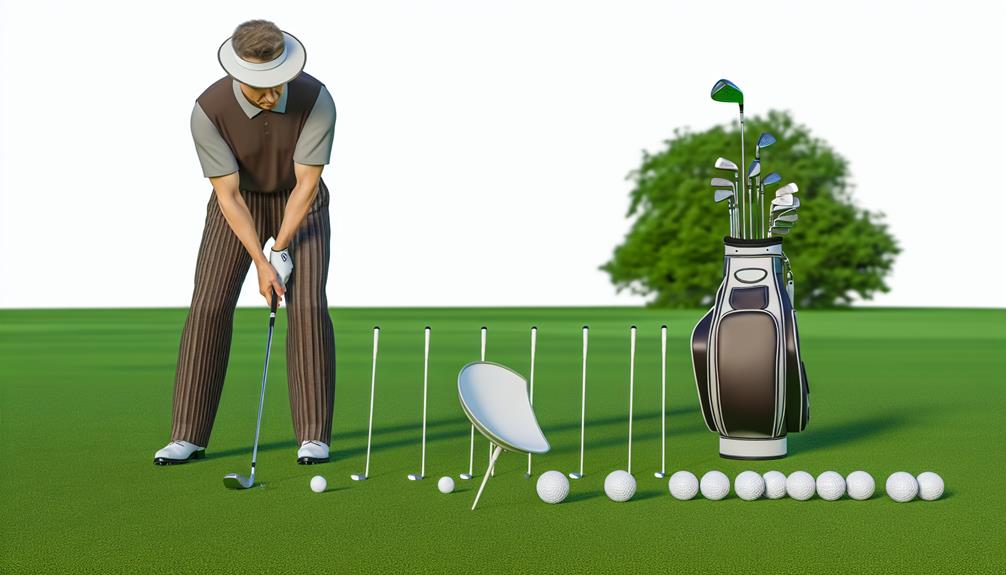Did you know that approximately 40% of your golf strokes are taken on the green? That's nearly half of your game spent putting, which makes mastering this skill absolutely paramount.
You might have a killer drive, but if you can't close the deal with a well-placed putt, you're not going to see the score improvements you want.
So, let's explore some top techniques to enhance your golf putting training.
The question is, are you up for a strategic change to your practice routine that could dramatically shift your game?
Understanding Golf Putting Basics
Before you can ace your putting game, it's essential to grasp the basics of golf putting. This involves understanding the green's topography, mastering the right grip, and perfecting your swing mechanics. Let's break it down.
Firstly, putting green selection is crucial. You've got to assess the lay of the land, look for slopes, and judge the grass type and cut. It's these details that can make or break your shot. Don't just see the green, understand it.
Next, ball positioning. It's not as simple as plopping the ball down anywhere. The ball's position in relation to your feet impacts the direction and distance of your putt. Typically, the ball should be slightly forward of the center of your stance. This helps you strike the ball on the upswing, promoting a smoother roll.
And then there's grip. A light but firm grip gives you control without sacrificing feel. The 'reverse overlap' is a popular choice, with your non-dominant hand at the top of the grip and the index finger of your dominant hand overlapping your other fingers.
Master these aspects and you're on your way to a stronger putting game.
Importance of Proper Grip
In the realm of golf, your grip is more than just a handshake with the club; it's the key to accuracy, control, and ultimately, your success in putting. This is where grip strength and grip consistency come into play. Both are critical elements that can significantly impact your performance on the green.
Grip strength isn't about how tightly you can hold the club, but rather the ability to maintain a firm yet relaxed hold. Too much tension can lead to inaccurate putts, while too little can cause the club to slip. It's about finding the right balance to ensure you can control the club without straining your hands or arms.
Grip consistency, on the other hand, refers to the ability to replicate the same grip every time you hold the club. It's not enough to have a good grip once; you need to consistently apply it. This consistency will help you develop a reliable and repeatable stroke, crucial for making successful putts.
Mastering the Putting Stroke
Having established the importance of grip strength and consistency, let's now turn our attention to mastering the putting stroke, a critical skill that can significantly enhance your golf game.
To master the putting stroke, you need to understand and apply the principles of putt psychology and stroke consistency.
Putt psychology refers to the mental aspect of putting. You need to develop a positive mindset, focusing on the hole and visualizing the ball's trajectory. It's about confidence; doubting yourself can lead to hesitation and inconsistency in your stroke.
Stroke consistency, on the other hand, is the physical component. To achieve it, you must practice your stroke until it becomes second nature. It's crucial to maintain a steady rhythm and repeat the same motion each time. This consistency will lead to better distance control and accuracy.
Incorporate these principles into your golf putting training to master the putting stroke. Dedicate time to both mental training for putt psychology and physical practice for stroke consistency.
As you refine these skills, you'll see a marked improvement in your putting performance and, ultimately, your overall golf game.
Implementing Effective Drills
To elevate your golf game, it's crucial that you implement effective drills into your training routine. Drill variety is key. By incorporating a range of drills, you'll ensure all aspects of your putting game are enhanced. This could include distance control drills, accuracy drills, or pressure drills. All these target different skills and, combined, can lead to significant improvement.
Consistent practice is equally vital. You can't expect to see improvements overnight. It's about repeating these drills regularly – consistency, rather than intensity, is what drives progress. Set a schedule, stick to it, and you'll gradually notice your skills developing.
Consider investing in a golf putting mat. This tool offers a practical way to practice your drills at home or in the office. It's an easy way to get in more repetitions, which is key for mastering any skill.
Analyzing and Adjusting Technique
Once you've established a consistent drill routine, it's crucial you analyze and adjust your technique to ensure you're capitalizing on your practice sessions. This requires a keen focus on posture analysis and mental preparation.
Posture analysis involves scrutinizing your stance, alignment, and movement during your putting stroke. Pay attention to your shoulder alignment – are they square to the target line? If not, you're likely pushing or pulling your putts off target. Your spine angle is also crucial. It should be slightly forward, allowing your arms to hang naturally.
As for mental preparation, it's just as important as physical technique. Visualize the path of the ball to the hole. This aids in establishing a clear image of the target, which in turn helps your brain guide your body to execute the perfect putt.
If you spot any flaws in your posture or mental approach, don't hesitate to adjust them. Remember, the goal of analyzing is to identify areas for improvement. It may seem tedious, but it's this meticulous attention to detail that will push you to become a better golfer. So, keep analyzing, keep adjusting, and most importantly, keep practicing.

